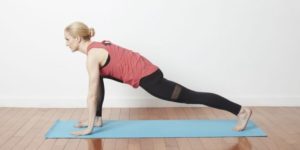Ballistic Stretching
Ballistic stretching is a sort of stretching that includes rapid and bouncing movements in a dull way & goals at moving the engaged muscles beyond their usual range of motion. It is not chosen to anyone, and particularly to beginners or amateur athletes, mostly because of its unsafe nature.

How Ballistic Stretching Works
To start off, ballistic stretching is built on the following notion: the individual attempts to exploit the push of their moving body or limb so as to power it to exceed its normal range of motion. The bouncing into a strained stance and then back out of it is vital in order to deliver the needed push for surpassing the normal limits of the muscle tissue. Your stretched muscles acts like a spring that will effort you out of the stretched position, and that is how ballistic stretching works.
Ballistic stretching is common between athletes, but is it safe for the normal person? This strong stretching technique uses bouncing activities to push your body away from its usual variety of motion.
While static stretches are done slowly and steadily, the ballistic technique stretches muscles much beyond and faster. You can do numerous similar stretches as ballistic or static stretches. For example, the ballistic technique of touching your toes would be to bounce and jerk near your feet.
People frequently confuse ballistic stretching with dynamic stretching. While both methods include movement throughout the stretch, they are dissimilar. Dynamic stretching doesn’t push muscles past their usual range of motion and there is no bouncing or tugging implicated. A best example of a dynamic stretch is arm circles. Dynamic stretching is more extensively suggested by doctors than ballistic stretching.
Can ballistic stretching be dangerous?
Although this type of stretching may be helpful for athletes, it carries a danger of wound. Ballistic stretching is usually not suggested for everyday people who want to stay in shape or improve flexibility because there is a danger of draining or dragging a muscle. Static stretching stretches muscles more mildly without risk of tugging them. The American Academy of Orthopaedic Surgeons alerts alongside bouncing stretches, as does the American College of Sports Medicine.
Stretching activities that are too powerful can harm the soft tissues around the joints, such as ligaments and tendons. This can progress into tendonitis. Over time, small muscle tears can mature and can clue to decreased flexibility and movement.
Example of Ballistic Stretching:
Example of ballistic stretching is bouncing up and down frequently to touch your toes. It is not useful and can lead to injury, it does not allow your muscles to change to, and relax in, the stretched position. It may cause them to tighten up by repeatedly activating the stretch reflex. If your sporting event requires a ballistic movement, then it may be proper necessary to conduct ballistic stretching exercises as part of your preparation.

Benefits of dynamic stretching:
- Dynamic stretching: means your body is continuously moving, even though stretching. The purpose of warming up is to make your muscles. You require to increase your muscles core temperature & dynamic stretching can achieve this.
- Dynamic stretching will make your muscles in a sport exact way. While static stretching warm up may loosen off the muscles, it has no relevance to what you are about to do. Whether you are preparing for a basketball game or going for a run. Your body needs to be ready for the intensity of whatever workout is ahead.
- Dynamic stretching makes you mentally prepared for the game. A static stretching warm up is comforting than anything else.
- Dynamic stretching helps to progress the range of motion around your joints. Over time this will recover your performance due to the increase in flexibility of your joints.

Takeaway
Ballistic stretching may be beneficial to certain people, as long as it’s done properly. A study in the British Journal of Sports Medicine found that ballistic stretching was better than the static stretching at improving the flexibility of hamstring powers at the back of the upper thigh in people with tight hamstrings. Tight hamstrings are a familiar cause for sports or workout injuries.
Before trying this method on your own, talk to your doctor about the risk versus benefits for your individual wants. Remember that while you should be able to sense a stretch, it should never be uncomfortable.
Submit your review | |

![Best 5 Health Supplement Website Online in India [2018] best health supplement website](http://www.vitaminhaat.in/wp-content/uploads/2018/08/best-health-supplements-websites-218x150.jpg)






















